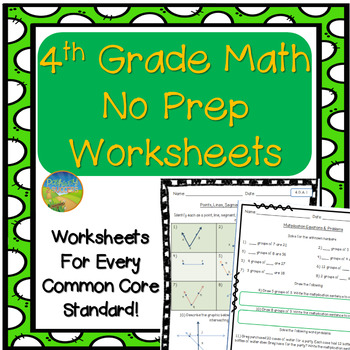4th Grade Math NO PREP Worksheets
Pathway 2 Success
79.1k Followers
Grade Levels
4th
Subjects
Resource Type
Standards
CCSS4.MD.A.1
CCSS4.MD.A.2
CCSS4.MD.A.3
CCSS4.MD.B.4
CCSS4.MD.C.5
Formats Included
- PDF
Pages
60 pages
Pathway 2 Success
79.1k Followers
What educators are saying
It was so nice to have ready to go activities for my gifted students. Many of them finish their work very quickly and this was an easy way to provide an additional challenge. I can also easily sub it in place if they already know something and need the additional extension.
Description
This 4th grade math worksheets document includes 28 easy-to-print math worksheets for 4th grade math. Every common core standard has a separate math worksheet. Standards include all areas: operations and algebraic thinking, number and operations in base ten, numbers and operations - fractions, measurement and data, and geometry. These worksheets would be great for morning work, small group math, intervention support, homework, or extra work for those who finish early. The worksheets are a blend of skill practice, real life application, and word problems.
No PREP!
Every worksheet includes a printable answer key worksheet. You can use the answer keys to correct answers, or post the answer key in the back of the room to allow students to check work entirely on their own!
While these worksheets are specifically aimed at 4th grade, they would also be useful for students below grade level in mathematics. This includes students requiring intervention support or special education services.
Buy the Bundle and Save!
— 4th Grade Math BUNDLE!
Save over 20% by buying the bundle! This is a bundle of 4th grade mathematics materials that includes task cards, math assessments, and no prep printable worksheets. All materials are aligned with 4th grade common core standards.
*****************************************************************************
Tips for Customers!
Click on the ★ above to follow my store!
If you have questions or problems please contact me through Product Q & A and I'll get back to you as soon as I can!
Disclaimer: These resources and materials are for supplementary support/education purposes and not intended as a replacement for counseling, education, or other necessary supports. Educators, parents, counselors, and others who utilize these materials are encouraged to seek out additional support, as needed.
*****************************************************************************
No PREP!
Every worksheet includes a printable answer key worksheet. You can use the answer keys to correct answers, or post the answer key in the back of the room to allow students to check work entirely on their own!
While these worksheets are specifically aimed at 4th grade, they would also be useful for students below grade level in mathematics. This includes students requiring intervention support or special education services.
Buy the Bundle and Save!
— 4th Grade Math BUNDLE!
Save over 20% by buying the bundle! This is a bundle of 4th grade mathematics materials that includes task cards, math assessments, and no prep printable worksheets. All materials are aligned with 4th grade common core standards.
*****************************************************************************
Tips for Customers!
Click on the ★ above to follow my store!
If you have questions or problems please contact me through Product Q & A and I'll get back to you as soon as I can!
Disclaimer: These resources and materials are for supplementary support/education purposes and not intended as a replacement for counseling, education, or other necessary supports. Educators, parents, counselors, and others who utilize these materials are encouraged to seek out additional support, as needed.
*****************************************************************************
Total Pages
60 pages
Answer Key
Included
Teaching Duration
Other
Report this resource to TPT
Reported resources will be reviewed by our team. Report this resource to let us know if this resource violates TPT’s content guidelines.
Standards
to see state-specific standards (only available in the US).
CCSS4.MD.A.1
Know relative sizes of measurement units within one system of units including km, m, cm; kg, g; lb, oz.; l, ml; hr, min, sec. Within a single system of measurement, express measurements in a larger unit in terms of a smaller unit. Record measurement equivalents in a two-column table. For example, know that 1 ft is 12 times as long as 1 in. Express the length of a 4 ft snake as 48 in. Generate a conversion table for feet and inches listing the number pairs (1, 12), (2, 24), (3, 36),...
CCSS4.MD.A.2
Use the four operations to solve word problems involving distances, intervals of time, liquid volumes, masses of objects, and money, including problems involving simple fractions or decimals, and problems that require expressing measurements given in a larger unit in terms of a smaller unit. Represent measurement quantities using diagrams such as number line diagrams that feature a measurement scale.
CCSS4.MD.A.3
Apply the area and perimeter formulas for rectangles in real world and mathematical problems. For example, find the width of a rectangular room given the area of the flooring and the length, by viewing the area formula as a multiplication equation with an unknown factor.
CCSS4.MD.B.4
Make a line plot to display a data set of measurements in fractions of a unit (1/2, 1/4, 1/8). Solve problems involving addition and subtraction of fractions by using information presented in line plots. For example, from a line plot find and interpret the difference in length between the longest and shortest specimens in an insect collection.
CCSS4.MD.C.5
Recognize angles as geometric shapes that are formed wherever two rays share a common endpoint, and understand concepts of angle measurement:





